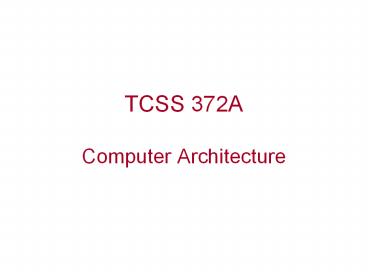TCSS 372A Computer Architecture - PowerPoint PPT Presentation
1 / 19
Title:
TCSS 372A Computer Architecture
Description:
... Device Data Register (maybe byte or word) State of Program (Context): PC, ... Address of Trap Service Routine loaded into PC. Service Routine Program executed ... – PowerPoint PPT presentation
Number of Views:57
Avg rating:3.0/5.0
Title: TCSS 372A Computer Architecture
1
TCSS 372A Computer Architecture
2
Getting Started
- Get acquainted (take pictures)
- Review Web Page (http//faculty.washington.edu/lcr
um) - Review Syllabus and Textbook
- Purpose, scope, and expectations of the course
- Expectations strategy for doing well
- Discuss Homework Format
3
Review ? from TCSS 371
- Simple machine Overview (LC-3)
- Memory map
- Architecture
- Instructions
- Addressing Modes
- Traps
- Subroutines (Functions)
- Activation (Context) Records
- I/O Interrupts
- Logic
- State machines
- Buses
4
LC-3 Memory Map
5
LC-3 Architecture Data Paths
Combinational Logic
Storage
State Machine
6
LC-3 CPU Registers PC Program counter
IR Instruction Register PSR (PSW)
Program Status Register (Program Status Word)
PSR15 Privilege Bit (Supervisor or
User State) PSR108 Priority
Bits PSR20 Condition codes -
N, Z, P Register File R7 Program Counter
storage R6 Stack Pointer R5 Context
Frame Pointer R4 Beginning of Global Data
Heap R3 R2 R1 R0 Often used
for Pass Value Special Hidden Registers
USP.Saved SSP.Saved Memory Read/Write Support
Registers MDR Memory Data Register
MAR Memory Address Register I/O Devices (Pair of
Registers per Device) DCR I/O Device
Status/Control Register (e.g. Ready/Done, EnIntr,
Priority) DDR I/O Device
Data Register (maybe byte or word) State of
Program (Context) PC, PSW, SP,
7
LC-3 Instructions
8
LC-3 Instruction Addressing Modes
- Register (Operand is in one of the 8 registers)
- Immediate (Operand is in the instruction)
- PC-relative (Operand is offset from the (PC) )
- Indirect (The Operand actually points to the
real address - rather than being the
operand) - Base Offset (Base relative) (Operand is
offset from the contents of a register) - Note no Direct Addressing defined in
the LC-3
9
Traps Subroutines
- How are Subroutines different from Traps ?
- Traps are called using the TRAP instruction
- (Indirect call through the Trap Vector Table)
- Subroutines are called using JSR or JSRR
instructions (JSR Direct call, JSRR Indirect
call) - Both end with a RET ( load the return address)
A Trap is an Subroutine call (Indirect) through
a Vector Table (the Trap Vector Table
x0000-x00FF).
10
Traps
- Execute TRAP vector - Operating System
Service Routines - 2) Trap Vectors are at memory locations
000000FF - Trap Vectors contain addresses of Trap Service
Routines - PC is stored in R7
- Address of Trap Service Routine loaded into PC
- Service Routine Program executed
- Trap service routine program ends with an RET
- ( R7 loaded into PC)
11
Allocating Space for Variables
x0000
Vectors
- Global data section
- All global variables stored here(actually all
static variables) - R4 points to beginning
- Run-time stack
- Used for local variables
- R6 points to top of stack
- R5 points to top frame on stack
- New frame for each block(goes away when block
exited) - Offset distance from beginning of storage area
- Global LDR R1, R4, x
- Local LDR R2, R5, -y
x0200
Op Sys
x3000
R6
run-time stack
R5
PC
instructions
R4
global data
xFE00
Device Registers
xFFFF
12
Activation Record or Context Frame Format
Function stacked stuff ..
.. Local Variables Callers Frame Pointer
(R5) Callers Return PC (R7) Function Return
Value Function Pass Value n
.. Function Pass Value 1
R6 Stack Ptr
R5 Frame Ptr
13
Interrupts
- Programmer Action
- Enable Interrupts by setting
intr enable bit in Device Status Reg - Enabling Mechanism for device
- When device wants service, and
- its enable bit is set (The I/O
device has the right to request service), and - its priority is higher than the
priority of the presently running program, and
- execution of an instruction is
complete, then - The processor initiates the
interrupt - Process to service the interrupt
- The Processor saves the state
of the program (has to be able to return) - The Processor goes into Privileged Mode (PSR
bit 15 cleared) - Priority level is set (established by the
interrupting device) - The (USP), (R6) ? USP.saved register
(UserStackPointer.saved) - The (SSP.saved) ? R6 (SupervisorStackPointer)
- The (PC) and the (PSR) are PUSHED onto the
Supervisor Stack - The contents of the other registers are not
saved. Why? - The CCs are cleared
14
Basic Logic Gates
15
2 BIT Decoder
Why are we interested in decoders ?
16
2-to-1 MUX
MUX Circuit Case S0
MUX Symbol
Why are we interested in MUXs ?
17
4-to-1 MUX
Symbol
Logic
18
Programmmable Logic Arrays (PLAs)
Why are PLAs cool ?
19
TCSS372A - HW1
Memory Map Activation Records Show the memory
map during execution of the following program at
point 1 , and the stack at points 1 through point
7.
- int main ()
- int a 23
- int b 14
- ...
- / point 1 /
- b Watt(a)
- / point 5 /
- b Volta(a,b)
- ... / point 7 /
- int Watt(int c)
- int w 5
- ... / point 2 /
- w Volta(w,10)
- / point 4 /
- ...































